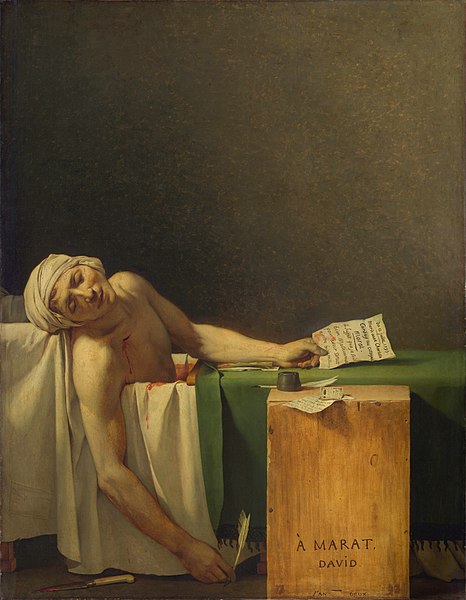The Lictors Bring Brutus the Bodies of His Sons
7:00 AM |
| Jacques-Louis David, The Lictors Bring Brutus the Bodies of His Sons, 1790 |
Jacques-Louis David, born in France, 1748, was unlike other renowned painters. His brush strokes bring to life images of immense aesthetic beauty. However, David’s works also heavily propagated ideas for revolution and nationalistic duty during a period of turmoil in France. He later emerged as the most influential painter during the Neoclassical movement, which occurred when art depicted the “moral climate” of France prior to the French Revolution (Turner).
Art always surrounded David throughout his life. His mother’s family included architects and painters, which influenced his education. He tried for an apprenticeship with François Boucher, his mother’s cousin. After being declined, he ended up as a pupil of Joseph-Marie Vien. David’s early life as a painter consisted of many consecutive failures. Each of his entries for the Prix de Rome, an art competition, kept falling short, though David possessed suspicions of misconduct within the voting committee. Finally, he won in 1774 with his work Erasistratus Discovers the Case of the Illness of Antiochus. In 1775, Vien and him travelled to Rome to explore the studies of 17th century art (Turner). David grew fond of Roman principles and society, which influenced many of his later Neoclassical works, including The Lictors Bring Brutus the Bodies of His Sons.
In 1789, David was commissioned to paint for King Louis XVI. He composed the work The Lictors Bring Brutus the Bodies of His Sons, shorty after the storming of the Bastille, a significant event during the French Revolution (Turner). This painting depicts Brutus, who led the overthrow of the Roman monarchy and helped establish the Republic. After Brutus’ sons were caught attempting to restore the monarchy, Brutus testifies for their execution. Clouded by darkness, Brutus patiently sits with his back turned to his headless sons. There is barely any visible anguish in his demeanor and appearance. He sits in a symbolic shadow to illustrate the darkness behind his gruesome betrayal. To the right of the composition, his wife and daughters contrast him, depicting misery and sorrow. The picture is split through the middle by a basket of cloth and sheers, diving one side to death and darkness while the other is filled with grief. Artistically, David paints the setting masterfully with the usage of pillars and the somber green tarp in the background to emphasize the family. Brutus’ body and face create an emotional discomfort for the viewer. Upon staring at him, one can see his intense loyalty to his country allowed him to make such a heinous decision. Truly, this is a moving work.
Why is this painting relevant to the French Revolution? It demonstrates the idea one must not let anything jeopardize the future success of their nation, even if that implies sanctioning the death of their family. During the Revolution, the masses wanted to overthrow the monarchy, and to do so they needed to rally together and invest themselves in France, making it their duty to protect and reform the country. This painting provokes such ideas, igniting an urge to serve France in the name of saving the country as Brutus did with Rome, no matter the costs. However, David did not originally intend such a political interpretation of his painting (Turner). Still, The Lictors Bring Brutus the Bodies of His Sons illustrates Neoclassical revolutionary ideas that David would quickly immerse himself in throughout the later course of the French Revolution, as seen through his other influential works including Death of Marat and Oath of the Horatii.
Source: The Dictionary of Art, Jane Turner











0 comments